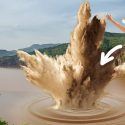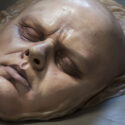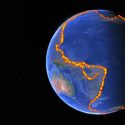In the beginning, there was nothing. Well, except for you. And the Big Bang. What would the first moments of the Universe be like? What would happen over the next thousands of years? And would anyone believe you?
Ah, The Big Bang theory. No, not the TV show. I’m talking about the most popular story about the earliest moments in the history of the Universe. According to this theory, the Universe emerged from a single point nearly 14 billion years ago. This point, known as a singularity, would have been infinitely dense.
From this singularity, the entire Universe expanded. Eventually cooling down enough to form stars, galaxies and planets like the one you’re on now. And our Universe is still expanding today. That’s one of the most compelling pieces of evidence supporting the Big Bang theory. So let’s travel back to a time where it all began.
Set your coordinates to 13.82 billion years ago. Time to take your shiny new time machine on an epic spin into the past. What you’d find when you arrived would be, well, nothing. You, and everything you’ve ever known, no longer exist. But by some miracle of your time machine-slash-spaceship, you’d arrive at the exact moment of the Big Bang.
Before this moment, all the particles that make up the Universe were crammed so tightly that not one atom could even form. In this state, the density was infinitely higher than the matter in our current Universe. Right after the Big Bang occurred, this matter existed in the form of quark-qluon plasma, or QGP.
Very quickly, in a matter of milliseconds, the particles making up this QGP would clump together to form the protons and neutrons that make up the atoms we know today. According to astrophysicist Paul Sutter, at this point, everything was crushed into a ball about the size of a peach.
This ball would have been very hot. How hot? Only like a trillion Kelvin. That’s 999 billion °C (1.8 trillion °F). But I wouldn’t blink if I were you. Because if you did, you’d miss the Universe rapidly inflating from the size of a basketball to roughly the size of the Sun. Particles would be flying through the QGP at velocities higher than the speed of sound. Like a jet traveling at Mach speed, these particles would emit a supersonic boom.
Of course, you wouldn’t hear anything. Sound can’t travel through the vacuum of space. Not to mention, you’d be witnessing a time before any matter has formed. Sorry to say, you’d barely be able to see anything either. Everything would look foggy and blurry. The super dense plasma would scatter light similar to water droplets in clouds.
One microsecond after the Big Bang, you’d see neutrinos, quarks and electrons form. Shortly after that, you’d see protons and neutrons forming. This would all be happening within one second. At this point, the temperature of everything would have dropped to a chilly 5.5 billion °C (10 billion °F). And after about three minutes, things would have cooled down enough for these protons and neutrons to form hydrogen nuclei.
You’d now be witnessing the era of nucleosynthesis. But don’t get ahead of yourself. You wouldn’t see the first elements form for another 380,000 years. All those years later, the Universe has finally expanded and cooled enough for electrons to stay in orbit around an atomic nuclei. The first hydrogen and helium atoms would form. You’d finally be able to see things more clearly, too.
Now you’ve reached the point in our creation timeline that scientists have some evidence of today. Cosmic microwave background radiation, or CMB, is leftover radiation from about 400,000 years after the Big Bang. These microwaves are invisible to the naked eye. But they reveal that there was a time when the Universe was both hotter and denser.
More proof that scientists point to in favor of this history of the Universe is the speed that galaxies appear to be moving away from us. Edwin Hubble observed that the furthest galaxies appear to be moving away from us faster than those closer to us. This would suggest that there was a time when all galaxies were in the same spot. The singularity.
Of course, you would have witnessed all of this firsthand. But without bringing back any definitive proof, the Big Bang would still remain a theoretical model of the history of the Universe. There would still be so many unanswered questions. And even if it was all true, would that really have been the beginning of everything?
Sources
- “What Triggered The Big Bang? It’s Complicated (Op-Ed)”. Paul Sutter. 2015. space.com.
- “How to catch a perfect wave: Scientists take a closer look inside the perfect fluid”. 2021. sciencedaily.com.
- “Exploring The First Microsecond Of The Cosmos”. 2021. medium.com.
- “The Big Bang | Science Mission Directorate”. 2022. science.nasa.gov.
- “How Did The First Chemical Element Appear In The Universe?”. 2018. astronomy.com.



























